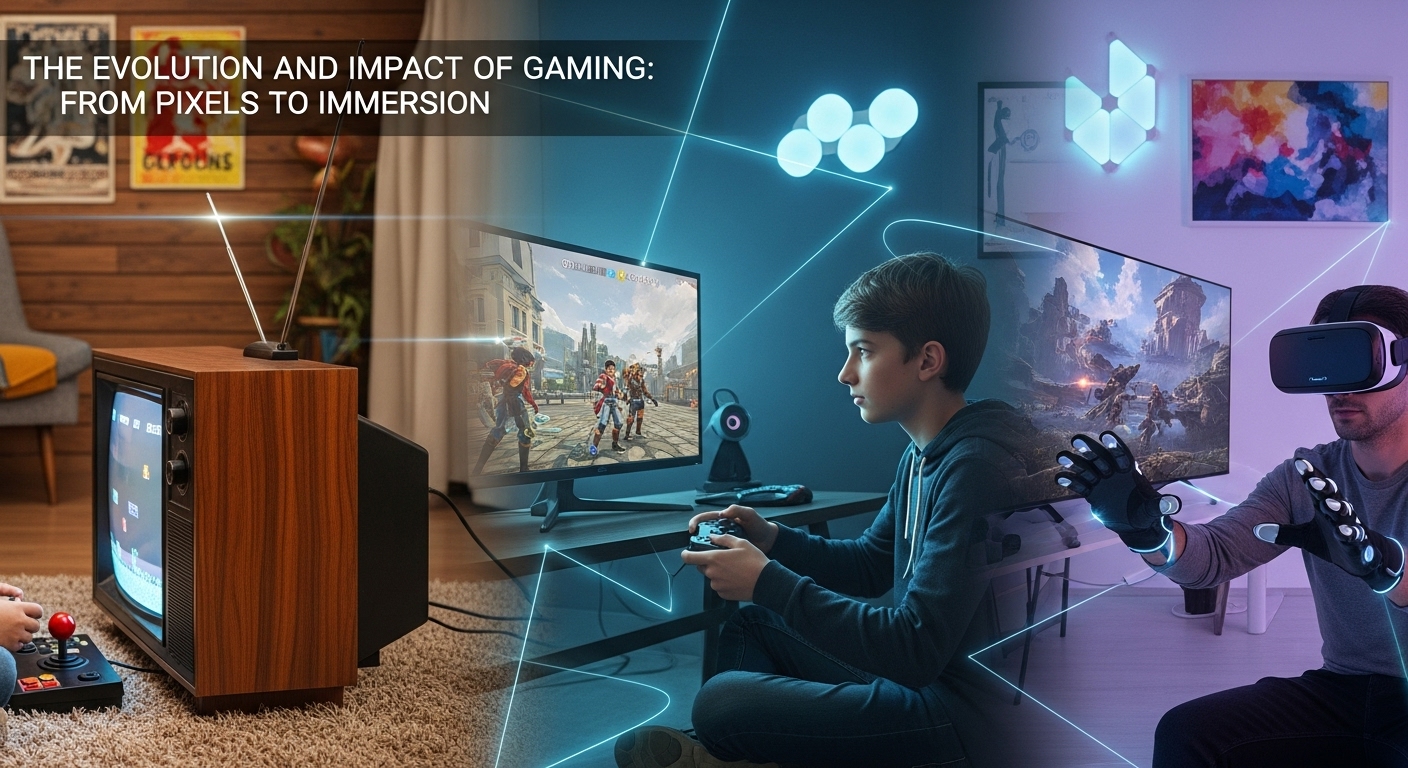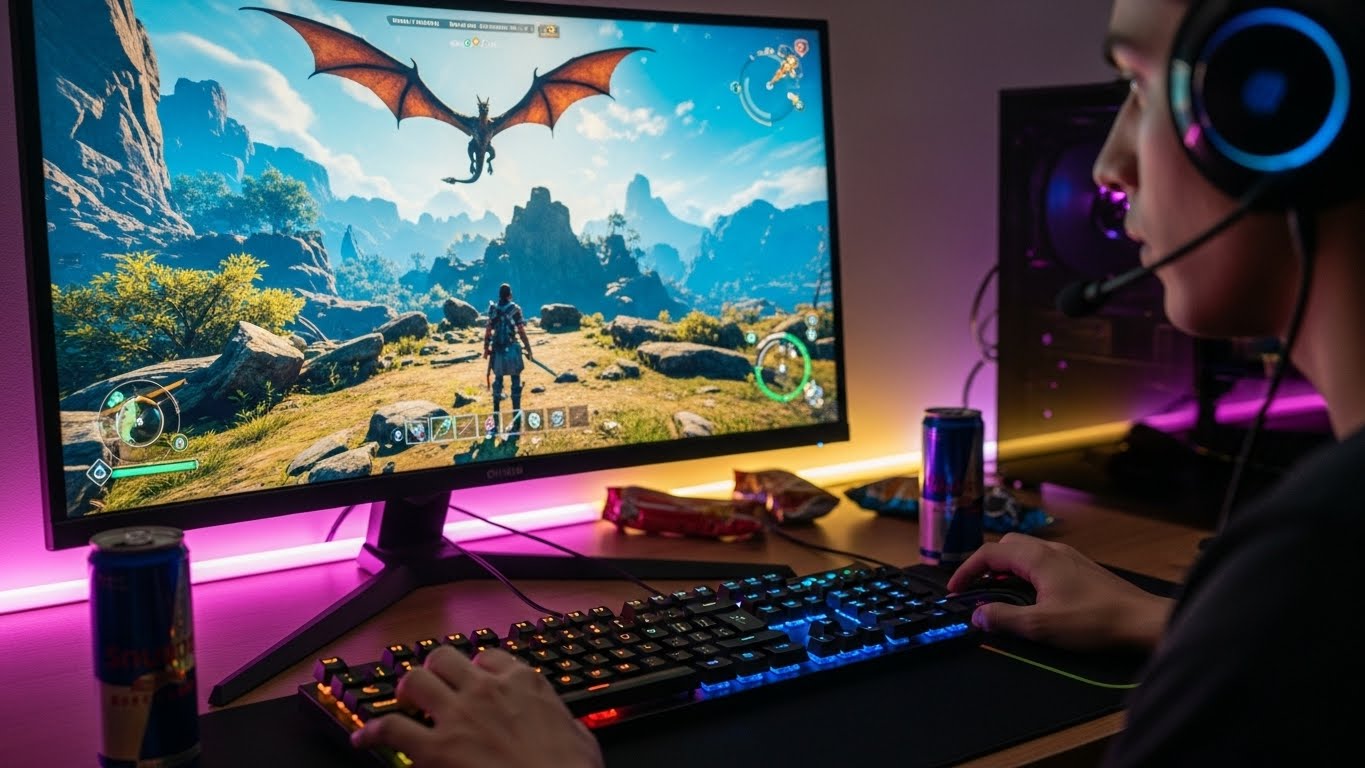Introduction: The Power of Play
Gaming is more than just entertainment. It is an art form, a social experience, and a technological marvel that has transformed the way we interact, learn, and even perceive the world. From the pixelated screens of the 1970s to the immersive virtual worlds of today, gaming has evolved into a multi-billion-dollar industry that influences culture, education, and innovation.
The journey of gaming is a fascinating one — shaped by creativity, competition, and constant technological advancement. It’s not merely about fun; it’s about storytelling, connection, and exploration. Let’s take a deep dive into the world of gaming — where it came from, where it stands, and where it’s going.
The Origins of Gaming: Where It All Began
The story of gaming begins long before digital screens existed. Humans have always been drawn to games — from ancient board games like Senet in Egypt to the strategic moves of Chess and Go. These early games reflected our desire for challenge, strategy, and competition.
However, the concept of digital gaming took root in the mid-20th century. In the 1950s and 60s, scientists and engineers developed simple electronic games as experiments. One of the earliest known examples was Tennis for Two (1958), a rudimentary simulation of tennis displayed on an oscilloscope. Then came Spacewar! (1962), which allowed two players to battle spaceships in a computer-generated environment.
These humble beginnings laid the foundation for an industry that would soon revolutionize entertainment.
The Golden Age: Arcade Games and the Birth of a Culture
The 1970s marked the birth of arcade gaming — the era that introduced gaming to the masses. Titles like Pong, Space Invaders, Pac-Man, and Donkey Kong turned gaming from a niche hobby into a global phenomenon. Arcades became social hubs, where players competed for high scores and bragging rights.
This was more than just a technological trend; it was a cultural shift. For the first time, games were accessible to everyone — kids, teenagers, and adults alike. The arcade machine became a symbol of the modern age, representing creativity and the spirit of competition.
These games also introduced iconic characters and gameplay mechanics that continue to influence modern gaming design.
The Console Revolution: Bringing Games Home
The 1980s saw a major transformation in how people played games. With the introduction of home consoles like the Atari 2600, Nintendo Entertainment System (NES), and Sega Master System, gaming moved from arcades to living rooms.
This era gave rise to franchises that are still beloved today — Super Mario Bros., The Legend of Zelda, and Metroid. These titles showcased how storytelling and gameplay could blend to create unforgettable experiences.
The console wars of the late 80s and 90s between Nintendo, Sega, and later Sony shaped the gaming landscape. Each company brought its unique style and innovation, from Sega’s edgy marketing to Nintendo’s family-friendly approach and Sony’s push for cinematic experiences.
Home consoles made gaming personal, creating a generation of players who grew up with controllers in their hands.
The Rise of the PC: Strategy and Innovation
While consoles were conquering homes, personal computers opened new doors for gaming. The PC platform offered flexibility, creativity, and the power to create complex worlds.
Games like SimCity, Doom, Warcraft, and The Sims became cultural landmarks. PC gaming emphasized customization and innovation, giving rise to genres like real-time strategy, simulation, and first-person shooters.
The modding community — players who modified and created their own content — also flourished on PCs. This creativity eventually led to the birth of new genres and even professional careers for modders who became game developers.
PC gaming became the platform for experimentation and innovation — a playground for both developers and players.
The Internet Age: Multiplayer and Online Worlds
The late 1990s and early 2000s brought one of the most significant revolutions in gaming history: online multiplayer.
No longer limited to single-player or local multiplayer, players could now connect with others across the globe. Titles like Counter-Strike, EverQuest, and World of Warcraft built communities that transcended borders.
Online gaming fostered social interaction and competition on an unprecedented scale. Guilds, clans, and leaderboards became a part of everyday gaming life. The concept of playing together, sharing strategies, and forming virtual friendships changed how people viewed games — not as solitary experiences, but as shared adventures.
The rise of broadband internet accelerated this shift, making online gaming smoother and more accessible.
The Modern Era: High Definition and Storytelling
As technology advanced, so did the complexity and artistry of video games. The 2000s to 2010s brought the era of high-definition graphics, realistic physics, and cinematic storytelling.
Games like Uncharted, The Last of Us, Mass Effect, and Bioshock showed that games could rival movies in emotional depth and narrative quality. Developers began exploring mature themes, moral choices, and immersive worlds.
The line between player and story began to blur. Players were no longer just observers; they became part of the story. Choices had consequences, and the emotional connection between player and character deepened.
This era also saw the growth of open-world games like Grand Theft Auto, Assassin’s Creed, and Skyrim, offering unprecedented freedom and exploration.
Mobile Gaming: The Revolution in Our Pockets
If consoles brought gaming home, smartphones brought gaming everywhere.
Mobile gaming exploded in the 2010s, turning casual players into gamers. Titles like Angry Birds, Candy Crush, Clash of Clans, and PUBG Mobile reached millions, breaking records and making gaming a universal pastime.
What made mobile gaming so powerful was its accessibility. You didn’t need expensive hardware or a console — just a smartphone. This democratized gaming, allowing people of all ages and backgrounds to enjoy it.
Mobile games also introduced new business models, like free-to-play with in-app purchases, reshaping the industry’s economy.
The Rise of Esports: From Hobby to Professional Career
Competitive gaming, or Esports, emerged as a cultural and economic powerhouse.
Games like League of Legends, Dota 2, CS:GO, and Fortnite transformed competitive play into full-fledged sports events. Millions watched tournaments online and in arenas, cheering for their favorite teams and players.
Professional gamers became celebrities, earning sponsorships, endorsements, and massive prize pools. Esports organizations now operate like traditional sports teams, complete with coaches, analysts, and training facilities.
This rise of Esports also helped validate gaming as a legitimate pursuit — one requiring skill, strategy, teamwork, and discipline.
Streaming and Content Creation: The New Entertainment Frontier
The next big wave came with streaming platforms, where gaming and entertainment merged. Platforms like Twitch and YouTube Gaming gave rise to a new generation of creators — streamers and Let’s Players — who built communities around their personalities and gameplay.
Watching someone play became as enjoyable as playing itself. Streamers connected with audiences in real-time, turning gaming into an interactive form of entertainment.
This era blurred the line between gamer and performer. For many, gaming became a full-time profession, and content creation became a new form of storytelling.
Virtual Reality and the Future of Immersion
The dream of stepping into a game world became a reality with the rise of Virtual Reality (VR) and Augmented Reality (AR).
VR headsets like the Oculus Quest, HTC Vive, and PlayStation VR transported players into fully immersive environments, where they could interact naturally with virtual spaces. AR games like Pokémon GO combined the digital and physical worlds, encouraging real-world exploration.
The technology is still evolving, but it represents the next frontier of gaming — a future where experiences are more tactile, realistic, and emotional.
Gaming and Mental Health: Beyond Entertainment
For years, gaming was unfairly criticized as a cause of violence or addiction. However, modern research and societal understanding have shown a more balanced picture.
Gaming can provide relaxation, cognitive benefits, and even therapeutic effects. It helps players develop problem-solving skills, hand-eye coordination, and strategic thinking.
Games are also being used in mental health therapy, helping people manage anxiety, PTSD, and depression through immersive and interactive environments.
Socially, games offer safe spaces for connection, particularly for those who feel isolated in real life. Online friendships formed through gaming can be meaningful and supportive.
The Art of Game Design: Creativity Meets Technology
Game design is a unique blend of art, science, and psychology. Every successful game is the result of thousands of creative decisions — from visual aesthetics and sound design to level layout and player mechanics.
Artists, writers, programmers, and designers collaborate to craft experiences that engage both mind and emotion. The process involves constant iteration and innovation, balancing challenge and reward to keep players invested.
Modern tools and engines, like Unreal and Unity, have made it easier than ever for independent creators to bring their visions to life, leading to a surge of indie games that emphasize artistic expression and originality.
Indie Gaming: The Rise of the Underdogs
Independent developers have reshaped the industry with fresh ideas and emotional storytelling.
Games like Undertale, Hollow Knight, Celeste, and Stardew Valley proved that you don’t need massive budgets to create meaningful experiences. Indie games often tackle personal themes, experiment with gameplay mechanics, and challenge traditional norms.
The indie movement democratized game development, inspiring a generation of creators and players to value creativity over commercialism.
Gaming Communities: The Heart of the Industry
Behind every great game lies a vibrant community.
From fan art and forums to cosplay and conventions, gaming communities bring people together around shared passions. Events like Comic-Con and gaming expos celebrate not only the games but the people who play them.
Communities also play a vital role in shaping the direction of games through feedback, mods, and discussions. Developers listen closely to players, creating a more collaborative relationship than ever before.
Cultural Influence: Games as Modern Mythology
Video games are no longer just entertainment — they are culture.
Games influence movies, music, fashion, and even language. Iconic characters like Mario, Master Chief, and Lara Croft have become cultural symbols. Soundtracks from games are performed in symphony halls, and storytelling in games often rivals that of literature and cinema.
Moreover, gaming has become a form of modern mythology. Each game world offers stories of heroism, struggle, and discovery — tales that resonate across generations.
The Future of Gaming: Where We’re Headed
The future of gaming is limitless. Emerging technologies like artificial intelligence, cloud computing, and blockchain are set to redefine how games are created and experienced.
AI will make non-player characters more intelligent and adaptive, while cloud gaming will remove hardware limitations, allowing anyone to play high-quality games on any device.
We’re also seeing a shift toward more inclusive design — games that represent diverse cultures, genders, and identities. This inclusivity is expanding gaming’s reach and deepening its emotional impact.
In the coming years, we can expect more immersive worlds, more personalized experiences, and new ways to connect across digital and physical spaces.
Conclusion: The Infinite Game
Gaming is not just a pastime; it’s a reflection of who we are — our creativity, our curiosity, and our desire to connect.
From the blinking pixels of early arcades to the breathtaking realism of modern worlds, gaming has evolved into one of humanity’s most powerful forms of expression. It brings together art, technology, and community in a way no other medium can.
As technology continues to advance, the essence of gaming will remain the same — the joy of play, the thrill of discovery, and the magic of shared experiences.
Gaming’s story is still being written, and we are all part of it — players, creators, dreamers, and explorers in a universe of infinite possibilities.



